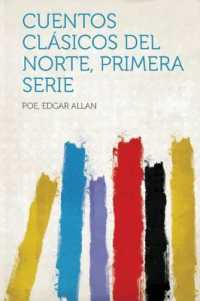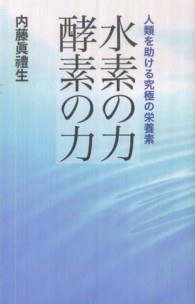- ホーム
- > 洋書
- > 英文書
- > Philosophy
Full Description
To the philosopher Boris Groys, everything technology produces in the modern world ultimately falls into two categories - it's art, or it's garbage. Both are useless, defunctionalized objects that simply lie there. The difference between them comes when we immunize art from the destructive power of time to which we devoutly deliver our garbage.
In this collection of essays and interviews, Groys expounds on these paradoxes, taking in art, the dialectic of work, the afterlife, politics, utopia, philosophy, faith, revolution, the avant-garde and digitalization. His philosophical writings critique the political economy of heterotopia, whereas his writings on art concern the things of the afterlife: only the politics of immortality promises salvation from the garbage pit.
Groys sees the history of class struggle as a history of aestheticization - defined by the forms spectators recognize as valuable enough to preserve, which they will fight to the death to preserve from disappearance and nonexistence. Western civilization's tendency to aestheticize politicizes everything. If we can design ourselves as artworks worthy of admiration and care, then can we too survive the ravages of time?
Bringing together previously unpublished texts, newly translated work and interviews, this is a coruscating trip through the complex and challenging philosophical and cultural problems that Boris Groys has made it his life's work to deal with.
Contents
Table of Contents
Introduction: The Production of Afterlife
Part One: Art, Culture and Utopia
Russia in Search of Its Identity (1992)
Into the Russian Soul (2021)
Alexandre Kojève: The Artwork as Embodiment of the Aesthetical Judgment (2024)
Pavel Filonov's Life Machines (1995)
Constructed Ideology (1994)
Soviet Oikonomia (2019)
Utopia Underground (1993)
Lenin and Lincoln: Two Figures of Modern Death (1993)
The Artwork as a Nonfunctional Machine: Vladimir Tatlin (1993)
Avant-garde and Politics. The End of Art and the End of Humanism? A conversation with Boris Groys (2021)
Part Two: The Step Back Anti-Philosophy and the Politics of Recognition (2020)
Caring for Tradition (2019)
Changing Topologies of the Class Struggle (2023)
Discourses of Distrust: Conspiracy Theories and the Critique of Ideology (2021)
Totalitarian Legacies (2019)
The Museum as a Cradle of Revolution (2020)
Part Three: Art and Politics
The Dark Side of Art (1996)
The Imagined Context: From Mikhail Bakhtin to Ilya Kabakov (1994)
The Production of the Other (1996)
Lenin's Image (2021)
Exhibiting the Exhibition, or Nostalgia in Reenactment (2022)
Followership vs. Spectatorship: The Two Regimes of the Contemporary Image (2022)
Becoming an Artwork (2021)
Notes
List of Texts








